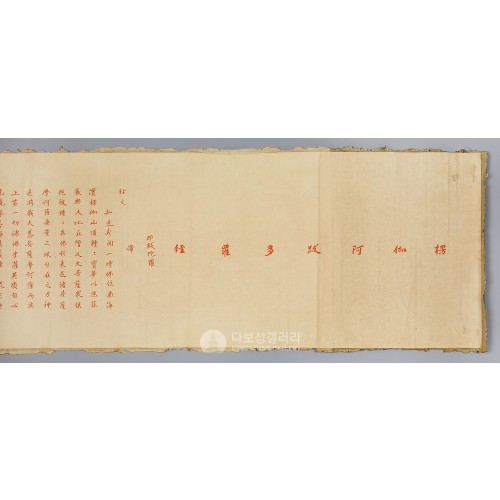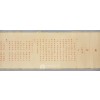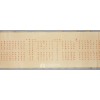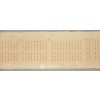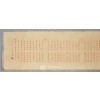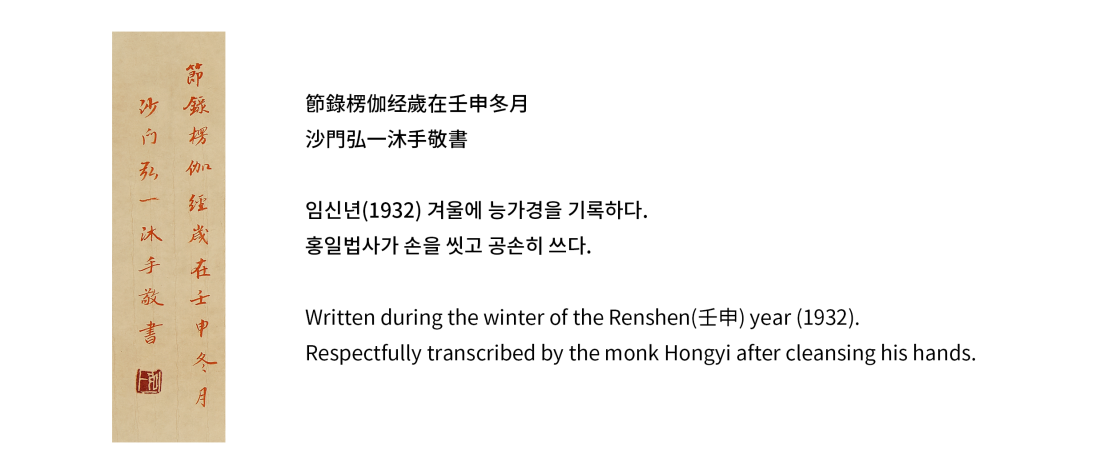본문
홍일법사가 능가아발다라보경(楞伽阿跋多羅寶經)을 사경(寫經)한 유물입니다.
사경에 쓰인 재료는 주묵(朱墨)으로 추정됩니다.
붉은 먹인 주묵은 주사(朱砂)를 이용해 제작한 먹으로, 예로부터 붉은 색으로 글씨나 그림을 그리면 삿된 것을 쫓는 벽사(辟邪)의 효능이 있다고 여겨져 왔습니다.
▣ 능가아발다라보경 (楞伽阿跋多羅寶經)
후기 대승 불교(大乘佛敎) 경전(經典)의 하나입니다.
석가모니가 능가성(楞伽城)에서 설파하였다고 전하는 경전으로 여래장사상(如來藏思想: 모든 인간은 여래와 같은 본성을 구비하고 있다는 입장)에 입각하여 그 이전의 여러 학파의 설을 풍부하게 채택하고, 이들 학설이 종교 경험과 어떻게 맺어져 있는가를 설명하고 있는 점에서 매우 중요시되는 경전입니다. 특히 초기의 선종에서 중시되었습니다.
구나발타라(求那跋陀羅)가 443년에 번역하였으며 우리나라에서 유통되고 있는 한역본(漢譯本)도 이것입니다.
▣ 홍일법사 (弘一法師) (1880~1942)
1880년, 중국 톈진에서 관공서 일을 맡던 거상(鉅賈)의 집안에서 태어났습니다.
22세에 상하이 남양공학에 입학하였고, 26세에 일본으로 유학을 떠났으며, 32세에 중국으로 돌아와 톈진공업대학에서 교직을 맡았습니다.
1916년에는 항저우 서호에 있는 정혜사(虎跑定慧寺)에 들어갔고, 1918년(39세)에 출가하여 승려가 되었습니다.
법명은 인음(寅音), 법호는 홍일(弘一)이며, 속명은 이숙동(李叔同)으로 알려져 있습니다.
그는 중국에서 최초로 서양 회화를 도입한 인물이며, 처음으로 오선지를 사용해 음악 교육을 실시한 사람입니다.
또한, 중국 최초의 화극사를 설립하는 등 예술 분야에서 선구적인 역할을 했습니다. 음악, 서예, 회화, 희극 등 다양한 방면에 깊은 조예를 지녔으며, 생애 중 50년 이상을 서예와 함께했습니다.
현대 서예가들 중에서도 그만큼 열정적으로 서예의 길을 걸었던 이는 드물며, 말년에는 자신만의 독창적인 서체를 남겼습니다.
그의 작품은 중국 서예 예술사에서 탁월한 성과로 평가받고 있습니다.
그는 모든 사람에게 '홍일 스승'으로 알려졌으며, 1942년에 복건성 천주시에서 61세의 나이로 평화롭게 세상을 떠났습니다. 홍일법사는 청나라 말기의 3대 시적 스님(시승 詩僧, 시에 능한 승려) 중 한명입니다. (다른 사람들은 수만수, 시정간입니다)
━━━━━
这是弘一法师手写的《楞伽阿跋多罗宝经》作品。
据推测,书写所使用的墨水为朱墨。
朱墨是使用朱砂制作的红色墨水,古人认为用红色书写文字或画图具有驱邪辟恶的功效。
自古以来,僧人们非常重视用血液或朱墨抄写经文,并且他们致力于在最上等的纸张上用精准的笔法书写。
▣ 《楞伽阿跋多罗宝经》
《楞伽阿跋多罗宝经》是大乘佛教的重要经典之一。
本经相传为释迦牟尼于楞伽城所宣讲,立足于如来藏思想—即一切众生皆具如来本性,广泛采纳了此前诸多学派的学说,并深入阐释这些学说与宗教体验之间的关联,因而在佛教思想发展史上占据重要地位。尤其在早期禅宗中备受推崇。
《楞伽阿跋多罗宝经》由印度高僧求那跋陀罗于公元443年译为汉文,现今在韩国流通的汉译本亦即此译本。
▣ 弘一法師 (1880~1942)
1880年出生于天津一官宦富商之家。
22岁时,他进入上海南洋公学学习,26岁时赴日本留学,32岁时回国并在天津工业大学任教。
1916年,他进入杭州西湖附近的虎跑寺,并于1918年(39岁)出家,成为一名僧侣。
法名演音,号弘一,俗名李叔同。
他是中国最早引入西洋绘画的人,也是首位使用五线谱进行音乐教学的人。
此外,他还在中国创办了第一所话剧学校等,成为艺术领域的开创者之一。
他在音乐、书法、绘画、戏剧等多个领域都有深厚的造诣,并且在生命中,有超过50年都在致力于书法。
即使在现代书法家中,像这样充满热情地走上书法之路的人也极为罕见,他在晚年创作了自己独特的书法风格。
他的作品被认为是中国书法艺术史上的杰出成就。
━━━━━
This is a transcription of the Laṅkāvatāra Sūtra by Hong Yi Dharma Master.
The material used for the transcription is presumed to be red ink (朱墨).
Red ink, made from cinnabar (朱砂), has long been believed to have the power to ward off evil when used for writing or painting.
Since ancient times, monks have considered it highly significant to transcribe scriptures using blood or red ink (朱墨), striving to write with precise calligraphy on the finest paper.
▣ Laṅkāvatāra Sūtra (The Sutra of the Precious Teaching on Laṅkā, 楞伽阿跋多羅寶經)
This is one of the scriptures of later Mahāyāna Buddhism.
It is said to have been delivered by the Buddha on Mount Laṅkā, and it presents the core idea of tathāgatagarbha—that all beings inherently possess the same enlightened nature as the Buddha. The text synthesizes a range of earlier teachings and connects them to personal spiritual experience. For this reason, it is considered a vital text, especially influential in early Chan (Zen) Buddhism.
The Chinese version most commonly used today was translated in 443 CE by the Indian monk Guṇabhadra. This translation is also the version known and transmitted in Korea.
▣ Hong Yi Dharma Master (弘一法師) (1880~1942)
Hong Yi Dharma Master was born in 1880 into a wealthy merchant family engaged in government affairs in Tianjin, China.
At the age of 22, he entered Nanyang Public School in Shanghai.
At 26, he went to Japan for further studies, and at 32, he returned to China to take a teaching position at Tianjin Industrial University.
In 1916, he entered Dinghui Temple (虎跑定慧寺) at West Lake in Hangzhou.
In 1918, at the age of 39, he became a monk and was given the Dharma name Yin Yin (寅音), with the monastic title Hong Yi (弘一). His birth name was Li Shutong (李叔同).
He was the first person to introduce Western painting to China and the first to use staff notation in music education.
Additionally, he established the first modern Chinese drama society, making significant contributions to the arts.
He excelled in various fields, including music, calligraphy, painting, and theater. Throughout his life, he devoted more than 50 years to calligraphy.
Few modern calligraphers have pursued the art as diligently as he did.
In his later years, he developed a unique and original calligraphic style, which is regarded as an outstanding achievement in the history of Chinese calligraphy.
He was known to everyone as "Master Hong Yi" and peacefully passed away in 1942 in Quanzhou, Fujian Province, at the age of 61. Hong Yi Dharma Master is regarded as one of the three great poet-monks of the late Qing Dynasty. (The others are Su Manshu and Shi Jingan.)
